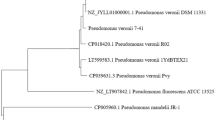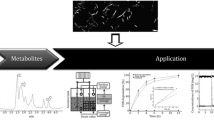Abstract
Pseudomonas sp. strain PP2 isolated in our laboratory efficiently metabolizes phenanthrene at 0.3% concentration as the sole source of carbon and energy. The metabolic pathways for the degradation of phenanthrene, benzoate and p-hydroxybenzoate were elucidated by identifying metabolites, biotransformation studies, oxygen uptake by whole cells on probable metabolic intermediates, and monitoring enzyme activities in cell-free extracts. The results obtained suggest that phenanthrene degradation is initiated by double hydroxylation resulting in the formation of 3,4-dihydroxyphenanthrene. The diol was finally oxidized to 2-hydroxymuconic semialdehyde. Detection of 1-hydroxy-2-naphthoic acid, α-naphthol, 1,2-dihydroxy naphthalene, and salicylate in the spent medium by thin layer chromatography; the presence of 1,2-dihydroxynaphthalene dioxygenase, salicylaldehyde dehydrogenase and catechol-2,3-dioxygenase activity in the extract; O2 uptake by cells on α-naphthol, 1,2-dihydroxynaphthalene, salicylaldehyde, salicylate and catechol; and no O2 uptake on o-phthalate and 3,4-dihydroxybenzoate supports the novel route of metabolism of phenanthrene via 1-hydroxy-2-naphthoic acid → [α-naphthol] → 1,2-dihydroxy naphthalene → salicylate → catechol. The strain degrades benzoate via catechol and cis,cis-muconic acid, and p-hydroxybenzoate via 3,4-dihydroxybenzoate and 3-carboxy-cis,cis-muconic acid. Interestingly, the culture failed to grow on naphthalene. When grown on either hydrocarbon or dextrose, the culture showed good extracellular biosurfactant production. Growth-dependent changes in the cell surface hydrophobicity, and emulsification activity experiments suggest that: (1) production of biosurfactant was constitutive and growth-associated, (2) production was higher when cells were grown on phenanthrene as compared to dextrose and benzoate, (3) hydrocarbon-grown cells were more hydrophobic and showed higher affinity towards both aromatic and aliphatic hydrocarbons compared to dextrose-grown cells, and (4) mid-log-phase cells were significantly (2-fold) more hydrophobic than stationary phase cells. Based on these results, we hypothesize that growth-associated extracellular biosurfactant production and modulation of cell surface hydrophobicity plays an important role in hydrocarbon assimilation/uptake in Pseudomonas sp. strain PP2.


Similar content being viewed by others
References
Adachi K, Iwabuchi T, Sano H, Harayama S (1999) Structure of the ring cleavage product of 1-hydroxy-2-naphthoate, an intermediate of the phenanthrene-degradative pathway of Nocardioides sp. strain KP7. J Bacteriol 181:757–763
Al-Tahhan RA, Sandrin TR, Bodour AA, Maier RM (2000) Rhamnolipid-induced removal of lipopolysaccharide from Pseudomonas aeruginosa: effect on cell surface properties and interaction with hydrophobic substrates. Appl Environ Microbiol 66:3262–3268
Banat IM, Makkar RS, Cameotra SS (2000) Potential commercial applications of microbial surfactants. Appl Microbiol Biotechnol 53:495–508
Barkay T, Navon-Venezia S, Ron EZ, Rosenberg E (1999) Enhancement of solubilization and biodegradation of polyaromatic hydrocarbons by the bioemulsifier alasan. Appl Environ Microbiol 65:2697–2702
Barnsley EA (1983) Phthalate pathway of phenanthrene metabolism: formation of 2′-carboxybenzalpyruvate. J Bacteriol 154:113–117
Beal R, Betts WB (2000) Role of rhamnolipid biosurfactants in the uptake and mineralization of hexadecane in Pseudomonas aeruginosa. J Appl Microbiol 89:158–168
Bouchez-Naitali M, Rakatozafy H, Marchal R, Leveau JY, Vandecasteele JP (1999) Diversity of bacterial strains degrading hexadecane in relation to the mode of substrate uptake. J Appl Microbiol 86:421–428
Buchanan RE, Gibbons NE (eds) (1974) Bergey's manual of determinative bacteriology, 8th edn. Williams and Wilkins, Baltimore
Dean SM, Jin Y, Cha DK, Wilson SV, Radosevich M (2001) Phenanthrene degradation in soils inoculated with phenanthrene-degrading and biosurfactant-producing bacteria. J Environ Qual 30:1126–1133
Desai JD, Banat IM (1997) Microbial production of surfactants and their commercial potential. Microbiol Mol Biol Rev 61:47–64
Doddamani HP, Ninnekar HZ (2000) Biodegradation of phenanthrene by a Bacillus species. Curr Microbiol 41:11–14
Georgiou G, Lin SC, Sharma M (1992) Surface-active compounds from microorganisms. Biotechnology 10:60–65
Gibson DT, Subramanian V (1984) Microbial degradation of aromatic hydrocarbons. In: Gibson DT (ed) Microbial degradation of organic compounds. Dekker, New York, pp 182–252
Goswami P, Singh HD (1991) Different modes of hydrocarbon uptake by two Pseudomonas species. Biotechnol Bioeng 37:1–11
Gu MB, Chang ST (2001) Soil biosensor for the detection of PAH toxicity using an immobilized recombinant bacterium and a biosurfactant. Biosens Bioelectron 16:667–674
Haferberg D, Hommel R, Claus R, Kleber HP (1986) Extracellular microbial lipids as surfactants. Adv Biochem Eng Biotechnol 33:53–93
Harpel MR, Lipscomb JD (1990) Gentisate 1,2-dioxygenase from Pseudomonas purification, characterisation, and comparision of the enzyme from Pseudomonas testosteroni and Pseudomonas acidovorans. J Biol Chem 265:6301–6311
Hayaishi O, Katagiri M, Rothberg S (1957) Studies on oxygenases: pyrocatechase. J Biol Chem 229:905–920
Iwabuchi T, Harayama S (1997) Biochemical and genetic characterization of 2′-carboxybenzaldehyde dehydrogenase, an enzyme involved in phenanthrene degradation by Nocardioides sp. strain KP7. J Bacteriol 179:6488–6494
Iwabuchi T, Harayama S (1998) Biochemical and molecular characterization of 1-hydroxy-2-naphthoate dioxygenase from Nocardioides sp. KP7. J Biol Chem 273:8332–8336
Kanaly RA, Haryama S (2000) Biodegradation of high molecular-weight polycyclic aromatic hydrocarbons by bacteria. J Bacteriol 182:2059–2067
Kiyohara H, Torigoe S, Kaida N, Asaki T, Iida T, Hayashi H, Takizawa N (1994) Cloning and characterization of a chromosomal gene cluster, pah, that encodes the upper pathway for phenanthrene and naphthalene utilization by Pseudomonas putida OUS82. J Bacteriol 176:2439–2443
Kobayashi H, Takami H, Hirayama H, Kobata K, Usami R, Horikoshi K (1999) Outer membrane changes in a toluene-sensitive mutant of toluene-tolerant Pseudomonas putida IH. J Bacteriol 181:4493–4498
Kojima Y, Itada N, Hayaishi O (1961) Metapyrocatechase: a new catechol-cleaving enzyme. J Biol Chem 236:2223–2228
Kuhm AE, Stolz A, Nagi KL, Knackmuss HJ (1991) Purification and characterization of a 1,2-dihydroxynaphthalene dioxygenase from a bacterium that degrades naphthalenesulfonic acid. J Bacteriol 173:3795–3802
Langworthy DE, Stapleton RD, Sayler GS, Findlay RH (2002) Lipid analysis of the response of a sedimentary microbial community to polycyclic aromatic hydrocarbons. Microb Ecol 43:189–198
Loosdrecht MC van, Lyklema J, Norde W, Schraa G, Zehnder AJ (1987) The role of bacterial cell wall hydrophobicity in adhesion. Appl Environ Microbiol 53:1893–1897
Lowry OH, Rosenbrough NJ, Farr AL, Randall RJ (1951) Protein measurement with Folin-phenol reagent. J Biol Chem 193:265–275
Maagd RA de, Rao AS, Mulders IH, Goosen-De RI, van Loosdrecht MC, Wijffelman CA (1989) Isolation and characterization of mutants of Rhizobium leguminosarum bv. Viviae 248 with altered lipopolysaccharides: possible role of surface charge or hydrophobicity in bacterial release from the infection thread. J Bacteriol 171:1143–1150
Makin SA, Beveridge TJ (1996) The influence of A-band and B-band lipopolysaccharide on the surface characteristics and adhesion of Pseudomonas aeruginosa to surfaces. Microbiology 142:299–307
Minagi S, Miyake Y, Fujioka Y, Tsuru H, Suginaka H (1986) Cell-surface hydrophobicity of Candida species as determined by the contact-angle and hydrocarbon-adherence methods. J Gen Microbiol 132:1111–1115
Moran AC, Olivera N, Commendatore M, Esteves JL, Sineriz F (2000) Enhancement of hydrocarbon waste biodegradation by addition of a biosurfactant from Bacillus subtilis O9. Biodegradation 11:65–71
Mukherjee RM, Bhol KC, Mehra S, Maitra TK, Jalan KN (1992) High cell surface hydrophobicity of virulent Entamoeba histolytica isolates. Trans R Soc Trop Med Hyg 86:396–398
Noordman WH, Wachter JH, de Boer GJ, Janssen DB (2002) The enhancement by surfactants of hexadecane degradation by Pseudomonas aeruginosa varies with substrate availability. J Biotechnol 94:195–212
Panagoda GJ, Ellepola AN, Samaranayake LP (2001) Adhesion of Candida parapsilosis to epithelial and acrylic surfaces correlates with cell surface hydrophobicity. Mycoses 44:29–35
Patel TR, Barnsley EA (1980) Naphthalene metabolism by pseudomonads: purification and properties of 1,2-dihydroxynaphthalene dioxygenase. J Bacteriol 143:668–673
Persson A, Osterberg E, Dostalek M (1988) Biosurfactant production by Pseudomonas fluorescens 378: growth and product characterization. Appl Microbiol Biotechnol 29:1–4
Phale PS (1994) Biodegradation of 1-naphthoic acid by a soil isolate Pseudomonas maltophilia CSV89. Ph D thesis, Indian Institute of Science, Bangalore, India
Phale PS, Savithri HS, Rao NA, Vaidyanathan CS (1995a) Production of biosurfactant "Biosur-Pm" by Pseudomonas maltophilia CSV89: characterization and role in hydrocarbon uptake. Arch Microbiol 163:424–431
Phale PS, Mahajan MC, Vaidyanathan CS (1995b) A pathway for degradation of 1-naphthoic acid by Pseudomonas maltophilia CSV89. Arch Microbiol 163:42–47
Rosenberg E (1986) Microbial surfactants. CRC Crit Rev Biotechnol 3:109–132
Rosenberg E, Ron EZ (1999) High and low-molecular-mass microbial surfactants. Appl Microbiol Biotechnol 52:154–162
Rosenberg M, Gutnick D, Rosenberg E (1980) Adherence of bacteria to hydrocarbons: a simple method for measuring cell surface hydrophobicity. FEMS Microbiol Lett 9:29–33
Saito A, Iwabuchi T, Harayama S (1999) Characterization of genes for enzymes involved in the phenanthrene degradation in Nocardioides sp. KP7. Chemosphere 38:1331–1337
Saito A, Iwabuchi T, Harayama S (2000) A novel phenanthrene dioxygenase from Nocarioides sp. strain KP7: expression in Escherichia coli. J Bacteriol 182:2134–2141
Samanta SK, Chakraborti AK, Jain RK (1999) Degradation of phenanthrene by different bacteria: evidence for novel transformation sequences involving the formation of 1-naphthol. Appl Microbiol Biotechnol 53:98–107
Sandrin TR, Chech AM, Maier RM (2000) A rhamnolipid biosurfactant reduces cadmium toxicity during naphthalene biodegradation. Appl Environ Microbiol 66:4585–4588
Schippers C, Gessner K, Muller T, Scheper T (2000) Microbial degradation of phenanthrene by addition of a sophorolipid mixture. J Biotechnol 83:189–198
Shreve GS, Inguva S, Gunnam S (1995) Rhamnolipid biosurfactant enhancement of hexadecane biodegradation by Pseudomonas aeruginosa. Mol Mar Biol Biotechnol 4:331–337
Singleton DR, Masuoka J, Hazen KC (2001) Cloning and analysis of a Candida albicans gene that affects cell surface hydrophobicity. J Bacteriol 183:3582–3588
Stanier RY, Ingraham JL (1954) Protocatechuic acid oxidase. J Biol Chem 210:799–808
Stenström TA (1989) Bacterial hydrophobicity, an overall parameter for the measurement of adhesion potential to soil particles. Appl Environ Microbiol 55:142–147
Takizawa N, Kaida N, Torigoe S, Moritani T, Sawada T, Satoh S, Kiyohara H (1994) Identification and characterization of genes encoding polycyclic aromatic hydrocarbon dioxygenase and polycyclic aromatic hydrocarbon dihydrodiol dehydrogenase in Pseudomonas putida OUS82. J Bacteriol 176:2444–2449
Tsoi TV, Kosheleva IA, Zamaraev VS, Trelina OV, Selifonov SA (1988) Cloning and expression of Pseudomonas putida gene controlling the catechol-2,3-dioxygenase activity in Escherichia coli cells. Genetika 24:1550–1561
Wibawan IW, Lammler C (1992) Relationship between group B streptococcal serotypes and cell surface hydrophobicity. Zentralbl Veterinaermed Reihe B 39:376–382
Yang Y, Chen RF, Shiaris MP (1994) Metabolism of naphthalene, fluorene and phenanthrene: preliminary characterization of a cloned gene cluster from Pseudomonas putida NCBI 9816. J Bacteriol 176:2158–2164
Zajic JE, Seffens W (1984) Biosurfactants. CRC Crit Rev Biotechnol 1:87–107
Zhang Y, Miller RM (1994) Effect of a Pseudomonas rhamnolipid biosurfactant on cell hydrophobicity and biodegradation of octadecane. Appl Environ Microbiol 60:2101–2106
Author information
Authors and Affiliations
Corresponding author
Rights and permissions
About this article
Cite this article
Prabhu, Y., Phale, P.S. Biodegradation of phenanthrene by Pseudomonas sp. strain PP2: novel metabolic pathway, role of biosurfactant and cell surface hydrophobicity in hydrocarbon assimilation. Appl Microbiol Biotechnol 61, 342–351 (2003). https://doi.org/10.1007/s00253-002-1218-y
Received:
Revised:
Accepted:
Published:
Issue Date:
DOI: https://doi.org/10.1007/s00253-002-1218-y




